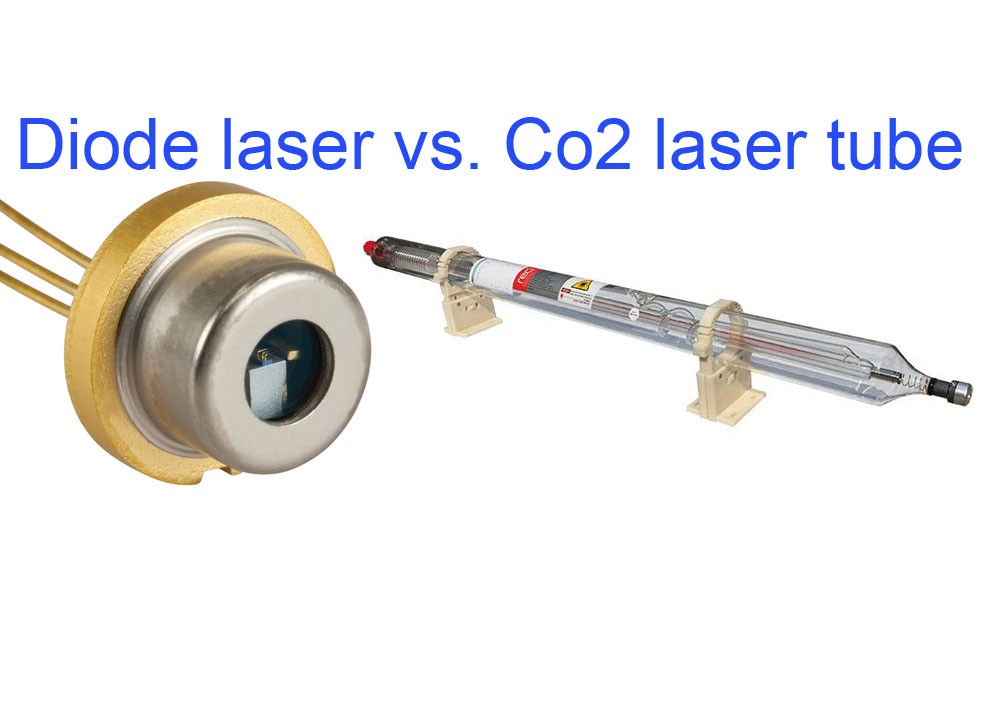CO2 vs. Diode Lasers: Know Pros and Cons
Ever wondered what makes a CO2 laser different from a diode laser? If you’re into laser cutting or engraving, understanding these two types of lasers can help you choose the right tool for your projects. In this guide, we’ll break down the pros and cons of each, making it easy to see which one fits your needs best.

Let’s dive in!
Understanding Laser Types
Before we get into the details, let’s understand what lasers are. Lasers are powerful beams of light that can cut, engrave, or mark materials. They come in different types, and each type has its own strengths and weaknesses. Today, we’re focusing on CO2 lasers and diode lasers.
What is a CO2 Laser?
A CO2 laser uses a mixture of gases, including carbon dioxide, to create a powerful beam of light. This type of laser is great for cutting and engraving a variety of materials like wood, plastic, glass, and even metal.
Pros of CO2 Lasers
- Powerful Cutting: CO2 lasers are very powerful and can cut through thick materials quickly and easily.
- Versatile: They can work with a wide range of materials, making them great for many different projects.
- Precision: CO2 lasers offer high precision, which is perfect for detailed and intricate designs.
Cons of CO2 Lasers
- Size and Cost: CO2 lasers are usually bigger and more expensive than other types of lasers.
- Maintenance: They require more maintenance and can be more complex to operate.
- Limited Portability: Due to their size, CO2 lasers are not as portable as other options.
What is a Diode Laser?
A diode laser uses semiconductors to create a laser beam. These lasers are smaller, more portable, and often more affordable than CO2 lasers. They are great for engraving and marking materials but may not be as powerful for cutting.
Pros of Diode Lasers
- Portability: Diode lasers are small and lightweight, making them easy to move around.
- Affordability: They are generally less expensive than CO2 lasers, making them a good option for beginners or hobbyists.
- Ease of Use: Diode lasers are simpler to operate and require less maintenance.
Cons of Diode Lasers
- Less Powerful: Diode lasers are not as powerful as CO2 lasers, so they may struggle with thicker materials.
- Limited Materials: They work best with certain materials and may not be suitable for everything.
- Slower Cutting: Diode lasers can take longer to cut through materials compared to CO2 lasers.
Comparing CO2 and Diode Lasers
Now that we know the basics, let’s compare CO2 lasers and diode lasers side by side.
Power and Speed
- CO2 Lasers: These are more powerful and faster at cutting through thick materials. They are ideal for heavy-duty projects.
- Diode Lasers: While not as powerful, diode lasers are still great for engraving and marking. They are better suited for lighter tasks.
Material Compatibility
- CO2 Lasers: Can handle a wide range of materials, including wood, plastic, glass, and metal.
- Diode Lasers: Work best with materials like wood, leather, and plastic. They may struggle with metal and glass.
Cost and Maintenance
- CO2 Lasers: More expensive and require regular maintenance. They are an investment but offer high performance.
- Diode Lasers: More affordable and easier to maintain. They are a good starting point for beginners.
Portability
- CO2 Lasers: Larger and less portable, making them better for workshops or fixed locations.
- Diode Lasers: Smaller and more portable, perfect for on-the-go projects or small workspaces.
Choosing the Right Laser for Your Needs
When deciding between a CO2 laser and a diode laser, think about what you need for your projects. Here are some tips to help you choose:
- Project Type: If you need to cut through thick materials or work with a variety of materials, a CO2 laser might be the better choice.
- Budget: If you’re on a tight budget, a diode laser can be a more affordable option.
- Space: Consider the space you have. If you need something portable, a diode laser is the way to go.
- Skill Level: If you’re a beginner, a diode laser might be easier to start with. If you have more experience, a CO2 laser can offer more advanced features.
Real-Life Examples
Let’s look at some real-life examples to see how these lasers are used:
- CO2 Laser: A woodworker might use a CO2 laser to cut intricate designs into wood for furniture or decorations.
- Diode Laser: A hobbyist might use a diode laser to engrave personalized gifts or create small craft projects.
Stay Tune With https://www.hituponviews.com/
Conclusion
Both CO2 lasers and diode lasers have their own strengths and weaknesses. CO2 lasers are powerful and versatile, great for heavy-duty projects. Diode lasers are affordable, portable, and perfect for lighter tasks. By understanding the pros and cons of each, you can choose the right laser for your needs and create amazing projects.
FAQs
Q: Which is better, a CO2 laser or a diode laser?
A: It depends on your needs. CO2 lasers are better for powerful cutting and versatility. Diode lasers are better for affordability and portability.
Q: Can diode lasers cut metal?
A: Diode lasers may struggle with metal. CO2 lasers are generally better for cutting metal.
Q: Are CO2 lasers expensive to maintain?
A: Yes, CO2 lasers require more maintenance and can be more expensive to operate.
Q: What materials can a diode laser engrave?
A: Diode lasers work well with materials like wood, leather, and plastic. They may not be suitable for metal and glass.
Q: How portable are diode lasers?
A: Diode lasers are very portable and easy to move around, making them great for small workspaces or on-the-go projects.









